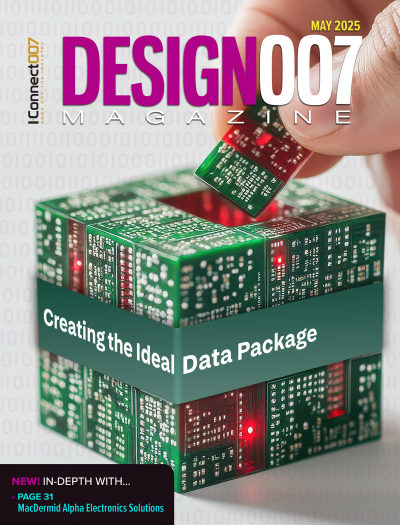-

- News
- Books
Featured Books
- design007 Magazine
Latest Issues
Current Issue
Showing Some Constraint
A strong design constraint strategy carefully balances a wide range of electrical and manufacturing trade-offs. This month, we explore the key requirements, common challenges, and best practices behind building an effective constraint strategy.

All About That Route
Most designers favor manual routing, but today's interactive autorouters may be changing designers' minds by allowing users more direct control. In this issue, our expert contributors discuss a variety of manual and autorouting strategies.

Creating the Ideal Data Package
Why is it so difficult to create the ideal data package? Many of these simple errors can be alleviated by paying attention to detail—and knowing what issues to look out for. So, this month, our experts weigh in on the best practices for creating the ideal design data package for your design.
- Articles
- Columns
- Links
- Media kit
||| MENU - design007 Magazine
An Optical Update with TTM
April 16, 2015 | Barry Matties, I-Connect007Estimated reading time: 6 minutes
Immonen: There are customers who are really looking at this for in a high-end routing, switching and in server infrastructure. That means high volumes. Obviously, supercomputing is an example of a very niche market. We want to see the potential in the high-volume markets.
Matties: When will you make this technology available in the marketplace?
Immonen: That probably will happen in a time frame of two to four years.
Matties: Why is it taking so long?
Immonen: Copper has made its way. We predicted that beyond 10 Gbps, it would be all optical, but we were wrong. We were predicting something around 16-18 Gbps, and now we're seeing 25 Gbps coming. But as the links will be shorter, the loss budget will be tighter, and the overall expense due to various chipsets needed to get clean the signals is significantly higher, customers are forced to look at other alternatives including optical.
Matties: In the world of technology, four years is an eternity. Is there something that could come and just bump this out of its place before you get it to market?
Immonen: Previously, the question was rolling around, optics vs. copper. Now it's more a question of which kind of optics will push the market first: multi-mode or single-mode, simple flex solutions or embedded optics, and at which wavelength, application or distance? We cannot put all of our fruit in one basket, so we are also developing a variety of options, including those that support the emerging silicon photonics technology which has made significant breakthroughs in recent years and has a lot of expectations.
Matties: Is this something you're going to license to others, or is this going to be an exclusive process for TTM?
Immonen: This is one option, definitely, licensing technology to others.
Matties: Well, thanks for sharing this story with us and I look forward to future updates.
Immonen: Thank you very much.
Related Presentation: Development of Optical Interconnect PCBs for High Speed Electronic Systems - Fabricator's View
RELATED VIDEO
Suggested Items
Happy’s Tech Talk #40: Factors in PTH Reliability—Hole Voids
07/09/2025 | Happy Holden -- Column: Happy’s Tech TalkWhen we consider via reliability, the major contributing factors are typically processing deviations. These can be subtle and not always visible. One particularly insightful column was by Mike Carano, “Causes of Plating Voids, Pre-electroless Copper,” where he outlined some of the possible causes of hole defects for both plated through-hole (PTH) and blind vias.
Trouble in Your Tank: Can You Drill the Perfect Hole?
07/07/2025 | Michael Carano -- Column: Trouble in Your TankIn the movie “Friday Night Lights,” the head football coach (played by Billy Bob Thornton) addresses his high school football team on a hot day in August in West Texas. He asks his players one question: “Can you be perfect?” That is an interesting question, in football and the printed circuit board fabrication world, where being perfect is somewhat elusive. When it comes to mechanical drilling and via formation, can you drill the perfect hole time after time?
The Evolution of Picosecond Laser Drilling
06/19/2025 | Marcy LaRont, PCB007 MagazineIs it hard to imagine a single laser pulse reduced not only from nanoseconds to picoseconds in its pulse duration, but even to femtoseconds? Well, buckle up because it seems we are there. In this interview, Dr. Stefan Rung, technical director of laser machines at Schmoll Maschinen GmbH, traces the technology trajectory of the laser drill from the CO2 laser to cutting-edge picosecond and hybrid laser drilling systems, highlighting the benefits and limitations of each method, and demonstrating how laser innovations are shaping the future of PCB fabrication.
Day 2: More Cutting-edge Insights at the EIPC Summer Conference
06/18/2025 | Pete Starkey, I-Connect007The European Institute for the PCB Community (EIPC) summer conference took place this year in Edinburgh, Scotland, June 3-4. This is the third of three articles on the conference. The other two cover Day 1’s sessions and the opening keynote speech. Below is a recap of the second day’s sessions.
Day 1: Cutting Edge Insights at the EIPC Summer Conference
06/17/2025 | Pete Starkey, I-Connect007The European Institute for the PCB Community (EIPC) Summer Conference took place this year in Edinburgh, Scotland, June 3-4. This is the second of three articles on the conference. The other two cover the keynote speeches and Day 2 of the technical conference. Below is a recap of the first day’s sessions.


